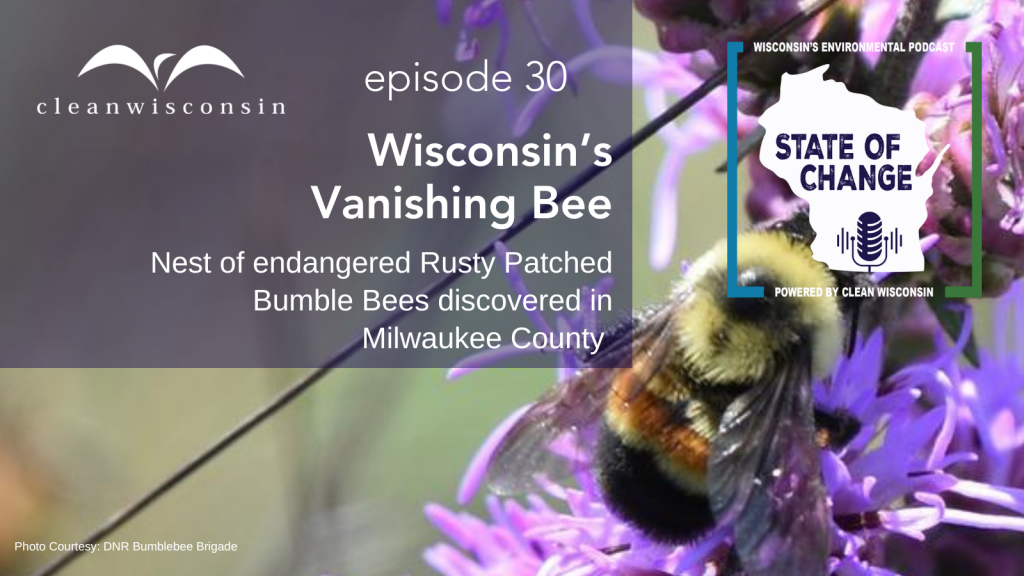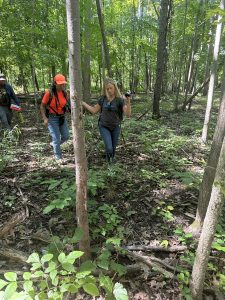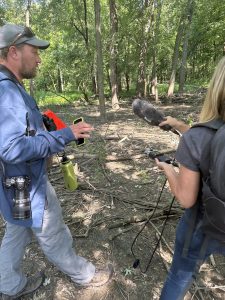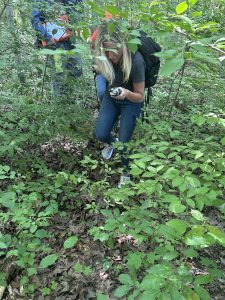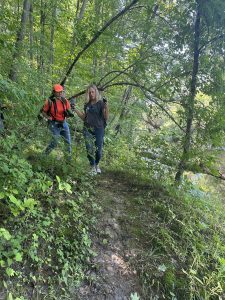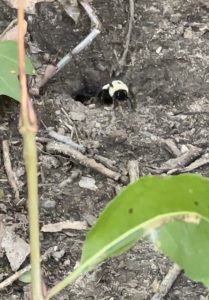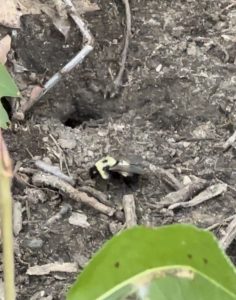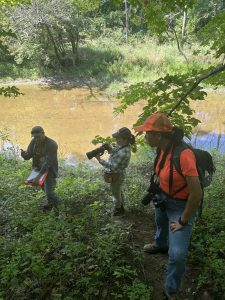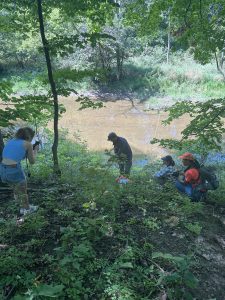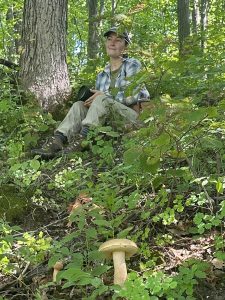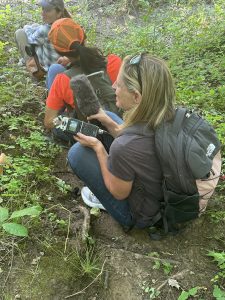Endangered Rusty Patched Bumble Bee nest discovered in Milwaukee County
Before the 1990s, they were everywhere in Wisconsin and beyond. Native Rusty Patched Bumblebees nested and foraged across 28 states and parts of Canada. Then the population hit a sudden, rapid decline. By 2017, the Rusty Patched Bumble Bee had become so scarce it was the first bee listed as a federally endangered species. In this episode, a walk deep into the Wisconsin woods for the rarest of discoveries: a nest of Rusty Patched Bumblebee queens. Amy looks at what it’s going to take to bring our bees back and meet the dedicated experts and volunteers who are working hard to save our pollinators.
Host:
Amy Barrilleaux
Guests:
Elizabeth Braatz, Bumble Bee Brigade Coordinator and Terrestrial Insect Ecologist, Wisconsin Department of Natural Resources
Jay Watson, Terrestrial Insect Ecologist, Wisconsin Department of Natural Resources
Halley Minser, Restoration Ecologist, Milwaukee County Parks
Background Reading:
Saving Wisconsin’s Native Pollinators
Corn Ethanol vs. Solar: A Land Use Comparison
Milwaukee County Parks: Conservation
Where to Listen:
Photos & Video From This Episode
View video from the podcast on our YouTube Channel
Full Transcript:
Amy Barrilleaux: How do you spend a warm, sunny morning? Well, if you’re one of the hundreds of volunteers, conservationists and researchers that make up Wisconsin’s Bumble Bee Brigade led by the DNR, chances are you’re on the lookout for the Rusty Patched Bumble Bee—trying to spot worker bees with the distinctive rust-colored patches on their backs and the bright yellow round queens. In August, all that work finally paid off when a rare nest of queens was discovered in a Milwaukee County park. That’s where I meet up with a handful of members of the Bumble Bee Brigade, including Elizabeth Bratz and Jay Watson from the DNR.
We hike off trail to reach the nest in an undisclosed location.
Amy: Why not disclose where we are? Why is this something you want to kind of keep on the down low?
Elizabeth Braatz: Yeah, absolutely. So this is a really, really special thing we’re about to see right now. It’s a Rusty Patched Bumble Bee colony or nest, and that is a federally endangered species. And we’re going to be we’re going to be really respectful, an we’re going to keep our distance. But if too many people go over there and start poking around or accidentally walk over things, they could step on the bees themselves and they could also disrupt the nest. And especially at this time when all of them are at the colony and they’re trying to get as fat as possible for winter, we just don’t want to disturb them and we want to preserve them so that more people can see Rusty Patched in their yards in the future.
Amy: This is, I think you said, the third nest that’s been found relatively recently. What does that mean? Does that mean that the Rusty Patched is coming back or that maybe we just have more people looking for them?
Elizabeth: Gosh, I hope I hope they’re coming back. I know all the places that these have been found have been with groups that have been working very hard to restore habitat and commit to protecting pollinators for the last several years. So it’s actually it’s really, really hopeful in my head to see that starting to hopefully pay off. Whether this will continue happening or that we just got really lucky this year, it’s hard to tell because we really need more data to kind of to tease apart whether this is survey effort versus the species themselves. But I hope this becomes something that becomes much more common.
Jay Watson Yeah, we think it’s really probably just more people out looking that have been educated on what to look for is really helping with finding more nests.
Amy: So how does having people out identifying nests help overall and in bringing this bee back?
Jay: Yeah, we know very little bit about their nesting requirements. So the thing we know the most about is foraging habitat. So part of their whole life cycle is their nest and we just are trying to learn more about what their requirements are, what the surroundings of it are, the soil types, all those different aspects of the nest. So the more we learn that we can help start to conserve those type of resources and stuff like that.
Amy: If we back up a little bit. The Rusty Patched Bumble Bee was the very first bee listed as a federally endangered species. Why are these bees particularly important? I mean, I think sometimes people think about animals in the way that they can help people. So honeybees, they make honey. That makes sense. Why is this bumble bee important?
Elizabeth: So there are 20 species of bumble bees in Wisconsin, and they as well as the 400 to 500 other native species of bees, are really, really valuable for pollination services that we all enjoy in. So if you enjoy having a diverse amount of food and those strawberries and squash and blueberries and all those other good things, as well as if you just go out and enjoy living in a green world and a blooming world, so many flowering plants that are wild and native, they have adapted over thousands of years to work with these native pollinators. So the Rusty Patched would be is kind of our our flagship species because they’re not doing as well as they used to. They were listed as listed as endangered because they used to be all the way out to the East Coast, to the ocean, all the way to west of us as well. And now that habitat has really shrunk. So we’re really trying to focus on them because they’re endangered. And Wisconsin actually has, fingers crossed, they seem to be we seem to be finding a decent amount of them in Wisconsin. So hopefully they can make a comeback. But it’s really all of those bumblebees and pollinators that we’re putting in habitat for are part of this ecosystem that we are all so reliant on.
Amy: When you found out that this nest had been found, what was your reaction?
Elizabeth: Oh, I was so excited. This is this is so amazing because there have been three rusty patched bumblebee nests found this year alone, 2023. And that is more than half of the ones that were found in total for the past 20 years. So it’s been a really good year for finding their nests. And that makes me really hopeful because we want to help protect their habitat. And learn what they even are using as habitat for their nests. And we can’t do that without ever finding the nests. So it’s been an exciting year for data this summer.
Amy: Well, let’s talk about what happened to the Rusty Patched Bumble Bee and I guess a lot of other pollinators. Why are they disappearing?
Elizabeth: There’s a lot of things stressing out. Pollinators in general, habitat loss is definitely one of the biggest ones, as well as intensified agriculture, pesticides, climate change and disease. And when you have all of those kind of adding on top of each other, it’s just a lot to stress out these pollinators and bees. The three nests were all found on Bumble Bee Brigade volunteers’ properties who had been working on Habitat for the past couple of years. So there’s plants that you can put in. There’s especially native plants that bloom throughout the season. So bumble bees, like us, like to be fed throughout their life. And so if you provide food in the spring, the summer and the fall, that really, really helps their life cycle. So even if some habitat is going away, if you kind of can provide habitat in government land, in public land and private land and gardens and even in company land as well, all of that can make a difference on the landscape. So that’s habitat loss. In terms of pesticides, reducing use in pesticides, especially systemic pesticides can really help because of of course, if you’re putting poison on the flowers and then bees are eating from them, that’s pretty bad for them.
Amy: So part of the reason why, you know, Clean Wisconsin is talking about pollinators and Rusty Patched Bumble Bees right now is because we like to see solar developments that have pollinator habitat planted in and around the panels. A lot of times that solar is replacing kind of like conventional agriculture, corn and soybeans. How important is it if we’re replacing that agriculture with something else, that we make sure that pollinators are taken care of in that moment?
Elizabeth: I think that’s a kind of key time that we have the opportunity to change the landscape, because if something’s already in place, it can be really hard and maybe not always worth it monetarily-wise to change. But if you’re already changing it, that’s your chance to do something new and to put in some of those plants that’ll provide habitat along the margins. And it doesn’t even have to be always the entire area. And it doesn’t have to be. Not that not everything has to be a restored DNR prairie. We’re not asking that. When I was working on solar plants previously, we were still kind of testing it out. That was in Florida, mind you. But we found that putting in habitat, even along the edge of the solar plant, was really, really helpful. And we were seeing an amazing diversity of insects come back to the site as soon as they started planting some around it. And then we were kind of slowly getting in under the under the panels. And I’m not sure how the solar industry in Wisconsin is doing, mind you. But that was that was what I saw in Florida
Jay: Solar panels are already being managed to keep out woody vegetation. So it’s really just getting that pollinator mix of plants established because a lot of those sites are 30 years, going to be 30 years for those easements that they have to keep those panels on. So it’s a great stable resource. Yes. If you put in the at the beginning, put it in a good mix of flowers that flower throughout the growing season, it provides a great resource for the bumblebees and other pollinators.
Amy: Do you think that we’ll get to a point where this was just kind of a blip when we weren’t thinking enough about pollinators? And now that we’ve made this discovery that they can be so delicate, delicate parts of the ecosystem that that will have a recovery.
Elizabeth: Yeah. So the question was, do we believe in the future of pollinators here in Wisconsin? And I think I get that answer every day when I open Bumble Bee Brigade and I see people’s photos and their hopes and the things that they’re seeing. I think it’s really a question of do we believe in the people of Wisconsin and having this multi-use landscape because the DNR cannot do this alone. We just don’t have enough land and people want that land for other things, too. But I think we I think we can coexist with these animals. I certainly hope so. And we’re going to keep spreading the word on how to do that, that everyone can do it, whether you own land or don’t. For example, the place that we’re going to right now is a reasonably densely populated county, but the people who manage this land rely on volunteers and all sorts of other passionate individuals to make this possible. So I think I think it’s possible.
Amy (narration): After a slow-going trek through thick woods and plenty of poison ivy, we reach the nest, not in a tree or a bed of flowers, but on the ground – a small hole in the wet soil, hidden in brush and fallen leaves.
Elizabeth: So bumble bees have annual colonies. It’s good to be a queen. We’re going to be seeing right now, hopefully is a lot of new queens for next year. That’s the sign of whether a colony was successful. But they’re starting to just go out and bumble around and get their legs and the wings under them. And sometimes they they’re not always flying around, sometimes just kind of walking around the ground. So we’re going to be really careful about stepping on them.
Halley Minser: You can come around and take a look right over here. This is activity that we’ve seen. Maybe Jay can offer some insight, but I’ve seen them. Or maybe they’ll just perch at the entrance of a nest. Perhaps it’s guarding behavior. Or they might just be checking out their new surroundings.
Amy: I’m going to say, I don’t know where the nest entrance is here.
Halley: Right where this camera is pointed at. And it’s very small. See, I’ve got a little queen right here, right here on the ground. So be really careful to avoid her. This is the nest entrance. It’s maybe two centimeters or less long. And you see that little queen?
Jay: That’s one of our smaller openings we’ve seen.
Halley: Yeah, I am shocked. It has to be half the size of the last one.
Jay: So a lot of times they use abandoned rodent burrows, which that could still be one. But that’s a lot of times you see them like a couple of inches wide, you know, three or four inches wide.
Halley: Wondering if they used a crayfish burrow for the nest?
Jay: Could be. That’s a great…
Elizabeth: That would be the first crayfish burrow, if that’s the case. That would be cool.
Jay: Yeah, that would be a new association.
Amy: So this queen right here, it looks like it’s not moving or…
Halley: She’s just hanging out.
Jay: Yeah. So this is different. So a lot of times when they first emerge, this is all things that we think we don’t exactly know. Right? We’re still learning. And they come out. You know, they’re produced underground. It’s all dark. So they’re coming out to the bright world and really they’re just getting used to their bodies, testing out their wings, learning, you know, just learning about their environment, the surroundings around them. So they’re, kind of just they sit there for a while and kind of just take everything in. We’ll see them sometimes, almost similar – you could compare it to like a butterfly. When they close their wings need to get strength. Then they’ll be flapping their wings around here around buzzing. And so they’re just getting their wings strengthened up before they can do that first flight. That’s all the kind of stuff going on when they first emerge. And then you’ll see them come back and forth like that to the nest. The other one was yellower, so we could kind of pick her out and follow her, she’d go make a flight 5 minutes away and then come back. You know, so they do a lot of that kind of stuff. There’s another one. That one’s actually really yellow right there.
Amy (narration): Hayley Minser, restoration ecologist with Milwaukee County Parks, discovered the nest. It’s the second nest she’s discovered in the last three years. So I guess why? What does it take to find one of these nests?
Halley: From my experience, it takes some dumb luck, really, just being out on the landscape a lot. I’m really fortunate because I’m out in the field 90 plus percent of the time for my job in a lot of really nice natural areas within Milwaukee County parks. And I’ve been managing the Bumble Bee Monitoring Program for Milwaukee County Parks for the last four years now, and we follow the protocol for the Bumblebee Brigade, of course. So just having lots of experience working with bumblebees and just having a really big passion for them, I think is what’s really led me to be able to discover this nest of the Rusty Patched Bumblebee in 2023 and then the other nest back in 2020. So really just a confluence of really good luck and all that I’ve learned from the program to be able to recognize these bees, be able to hear the queens when they’re flying around really loudly.
Amy: So what we’ve been looking at is a nest of new queens coming out of the ground. You know, the first kind of moments above ground. When you see that, how does it make you feel?
Halley: I just get unbelievably happy. Even when I see a bee, just a bumble bee, I get ecstatic about it. I didn’t remember saying it, but I had my coworkers with me. And so my coworker, Emily, we both discovered the nest together. And apparently what I said is, “Oh, a bee, let’s be friends!” Something along that line. And so the fact that it ended up being a nest and not just any nest, but of this federally endangered species is really–I’m breathless. I’ve been out here. Luckily, my boss has given me some time to come out here and observe the nest and study it. But I’ve come out of my free time on the weekends already, so just being able to, I really can’t put it into words. It’s an amazing experience. I thought it was a once in a lifetime one, but apparently I lucked out and got to do it twice.
Amy: So while we’re sitting here talking, we’re watching these queens kind of buzz around the area, I mean, there’s one right there. How rare is that?
Halley: I mean, you have to be at the right time of year. So you’re only really going to see the Queens in early spring when they emerge from their overwintering. And then this time of year when they’re new queens emerging from the nest as they’re going to mate and then overwinter. So there’s really only a set number of weeks. So it is phenomenal to be able to see them. And just seeing one, as I already said, really makes you very ecstatic. So seeing all of these together and seeing them not just on flowers, which is where all of us are really seeing bees, most of the time seeing them in their nest environment and taking their very first flights of their lives is absolutely unbelievable.
Amy: When you think about the future of these bees and really all the pollinators in Wisconsin, what brings you hope?
Halley: Seeing all of the volunteers, I really have to go ahead and say that, just like Elizabeth was saying, all of the work that these volunteers do is absolutely phenomenal. This is really what we need because we need this baseline data. We’ve been gathering that for years now with the Bumble Bee Brigade, thanks to the DNR folks leading that program. But then we are gathering this information on nesting habits of not just this species but others, so that we can use all of this data to help bumblebees and pollinators more in general. So I really think that there is a bright outlook for these pollinators, as everybody works together, as the public begins to become more aware of the issues that they face and what they can help to do for these threatened pollinators in their own lives and in their own gardens.
Amy (narration): The brigade spends about an hour at the nest collecting valuable data they hope will lead to more discoveries and better ways to protect nesting habitat.
Amy: So how exciting is it for you to see those bees coming in and out?
Elizabeth: Oh, it warms my heart. It’s awesome. It’s so, so magical. It’s so amazing. We get so used to just seeing these plump little creatures on our flowers and you forget that there’s a whole complex lifecycle that’s going on around us and under us that is so important for them. So getting to see I mean, I’m excited if I see a Rusty Patched Bumble bee worker in during a survey where I’m going out for hours and looking for bees. And so to see, gosh, you’ve probably seen maybe three or four queens, new queens for next year… Oh, there goes another one! Now it may be number five, but maybe it’s the same one–that’s the limitation of no mark and recapture–all in the same area, which is absolutely amazing. And this is exactly what we’re hoping to see, too, because this means that this colony, oh, is a little worker. .
Jay: I would just add there’s no guarantee. They get predated on a lot, so they can start a nest or they have failures. So awesome to see them make it to where you know, they’re producing new reproductive queens. Here comes another one out…
We had a site in La Crosse. Bunch of activity. Never produced any reproductive females. So really, for the future generation, it was it didn’t contribute to that generation. So that happens a lot. There’s a lot of failures. So it’s awesome to see when they’re successful, too.
Elizabeth: That’s one of the things that a lot of researchers are trying to look into, okay, what makes a nest successful? How can we get more nests to be successful? How do we provide habitat for their entire life cycle?
Amy: For photos and videos of the nest and bees and more information about how you can protect pollinators, visit cleanwisconsin.org. I’m Amy Barrilleaux, and you’ve been listening to State of Change, powered by Clean Wisconsin.
